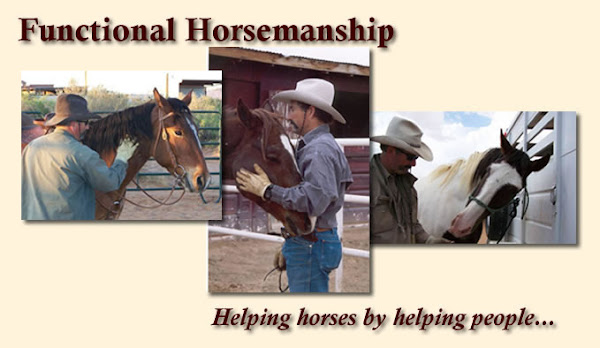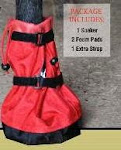James wrote to ask about getting a horse started on dragging objects. "I'd like to be able to drag things off my horse. She seems to be skittish with things behind her. I was told to begin by having someone drag a tarp or a bag and following behind on horseback. I'm not sure how to transition to dragging an object while riding and besides I am by myself most of the time. Do you have any tips on training a horse to drag things?"
Riders wanting to be able to drag something like a bag of tin cans is pretty popular due to this being a common task at obstacles challenges. Having someone help you out by pulling a bag, log or tarp, or whatever, and you trailing it on horseback is a very good way to start.
If you are by yourself you can do this when leading the horse and dragging something on the other side of you away from the horse. Maybe start with a short piece of rope and build up from there......maybe a empty feed sack
When I have a rider and horse who is scared of a drag bag or log, I'll often drag the object on horseback and have the riders follow along. I'll stop so often so the rider's can approach the object and get their horses to sometimes drop their noses onto it, which is instinctive for a horse. The horse's fearfulness on the dragging item goes away pretty quick. However, doesn't mean they are sacked out on dragging the object themselves.
I always try to get a horse used to ropes being thrown around it and there are many ways to go about this. In the beginning, I'll toss the end of my lead rope over the horse's back. When I need a longer rope, I'll use a lariat most of the time and throw it over the other side of the horse and rebuild my coils by pulling the rope over the horse's hip and then around the horses back legs. I'll do this many times pulling the lariat around his back feet, his hocks and higher up the leg.
I have rider's tell me they can drag bags but they get surprised when their horse turns away from the object and the taunt rope touches their hip,....well, bronc rides have ensued. This could have largely been eliminated by getting the horse good at ropes around their back end, being careful not to get the rope underneath their tail, which is called rim fired. Horse's generally don't like that, ha!
In Figure 1, I am pulling my lariat around the back end of the Jake.
Like I described above, whether it's a green young horse or an older horse, I like to get the horse good at ropes around their feet for many reasons, such as if I get careless with lariat or I get caught up in wire. Years ago I rode a young Paint horse up in the foothills of the Sacramento Mountains and cresting a small hill we found ourselves in some old barb wire on the ground. I dismounted and got my fencing pliers out to cut away the wire. My horse stood still because I had worked with him on ropes around his legs and he was good about ground tying while I cut the wire away. This story doesn't end there. When I cut the wire away from his front feet he stepped one foot forward and right onto my foot breaking a toe.
So sacking a horse out with ropes everywhere is not only necessary to safely dragging objects but helps if they get tangled in wire. Working on this also includes building on their comfort with the ropes touching them by getting them leading by a rope around a foot. I use both leads rope and lariat to do this. At first I just loop the lead rope around a front foot and pull as light as I can to get the horse to give me his foot, then I release. Once the horse is good about each front foot, I work on the back feet. This may be the same thing you do before you start to pickup a green horse's feet getting them ready for the horseshoer. When leading the horse by a front foot, a 12' lead ropes generally works, but I'll usually use a lariat for a back foot because they are longer, and it's easy to build a small loop and have the horse step into it. The trick on this is to again pull as light as you can and as the foot comes off the ground, continue your pull so that the horse puts the foot forward, and as the foot is in transition moving forward, release the pressure. That's what I am doing in Figure 2, leading a horse by his back left foot. Once I get that foot hitting the ground, I'll use the lead rope to ask him to take a step forward with the left front.
I usually start a horse dragging a light load such as a small log by holding onto the rope and backing the horse up with the object dragging towards us. It may seem that a horse would panic as the new object seems to be approaching him, but I have never experienced that, instead avoid any response like that by just going slow about it. I'll stop and walk the horse up to the object, then back the horse up dragging the object a bit, then stop and approach the object again. So this is back a step, approach a step and build on that. Your horse will let you know how much more he can handle and just how fast he can get get good at this. And if you are fairly handy you can slip the rope, increasing the distance between the horse and the object, then stop the horse and pull the object closer to you.
When doing this for the first time it's likely NOT a good idea to dally the dragging object's rope, instead just hang onto it with your free hand so you can can drop it if needed.
When I feel the horse is ready, I'll turn and walk away from the object letting the horse pull it. I'll move his back end into the rope lightly a few times to see how he takes the feel of the rope touching his hip or leg, and if he is good about it I'll start making turns and the rope will run across his hip with more pressure. You really can't say your horse is good at dragging until you know how he handles the rope running across his hips and hocks. Figure 4, 5 and 6 above depict this process.
I use a small log, getting the horse to trot out dragging it, then progress to a heavier log and trotting the horse out. Some people may not need to be able to trot and drag, but most times you have to trot to the ground crew when you have a calf on the end of your rope.
When I feel the horse is ready, I'll turn and walk away from the object letting the horse pull it. I'll move his back end into the rope lightly a few times to see how he takes the feel of the rope touching his hip or leg, and if he is good about it I'll start making turns and the rope will run across his hip with more pressure. You really can't say your horse is good at dragging until you know how he handles the rope running across his hips and hocks. Figure 4, 5 and 6 above depict this process.
I use a small log, getting the horse to trot out dragging it, then progress to a heavier log and trotting the horse out. Some people may not need to be able to trot and drag, but most times you have to trot to the ground crew when you have a calf on the end of your rope.
The length of the rope you are using will impact on where the rope lays across the horse's back end and where it applies pressure if turning away from the object. The safety points here are: not to have too short a rope where the object bangs into one of your horses back feet; not to dally until you are absolutely ready to. Again without taking turns around your horn, it's more easy to throw the rope away if you get into trouble.
Another safety point is how you tie your rope to the object you are dragging. I drill a hole through the piece of wood or log, run the rope through and tie a bowline. Be careful not to make a loop large enough for a horse to get his foot through. In fact, it's probably safer to use a timberhitch on the wood to eliminate any loops. And the last safety point is not to hard tie the rope to your saddle. While I have lunged a horse and have him drag an object, I just looped the rope around the saddle horn without a complete turn so I could get rid of it if needed.

Another safety point is how you tie your rope to the object you are dragging. I drill a hole through the piece of wood or log, run the rope through and tie a bowline. Be careful not to make a loop large enough for a horse to get his foot through. In fact, it's probably safer to use a timberhitch on the wood to eliminate any loops. And the last safety point is not to hard tie the rope to your saddle. While I have lunged a horse and have him drag an object, I just looped the rope around the saddle horn without a complete turn so I could get rid of it if needed.
















